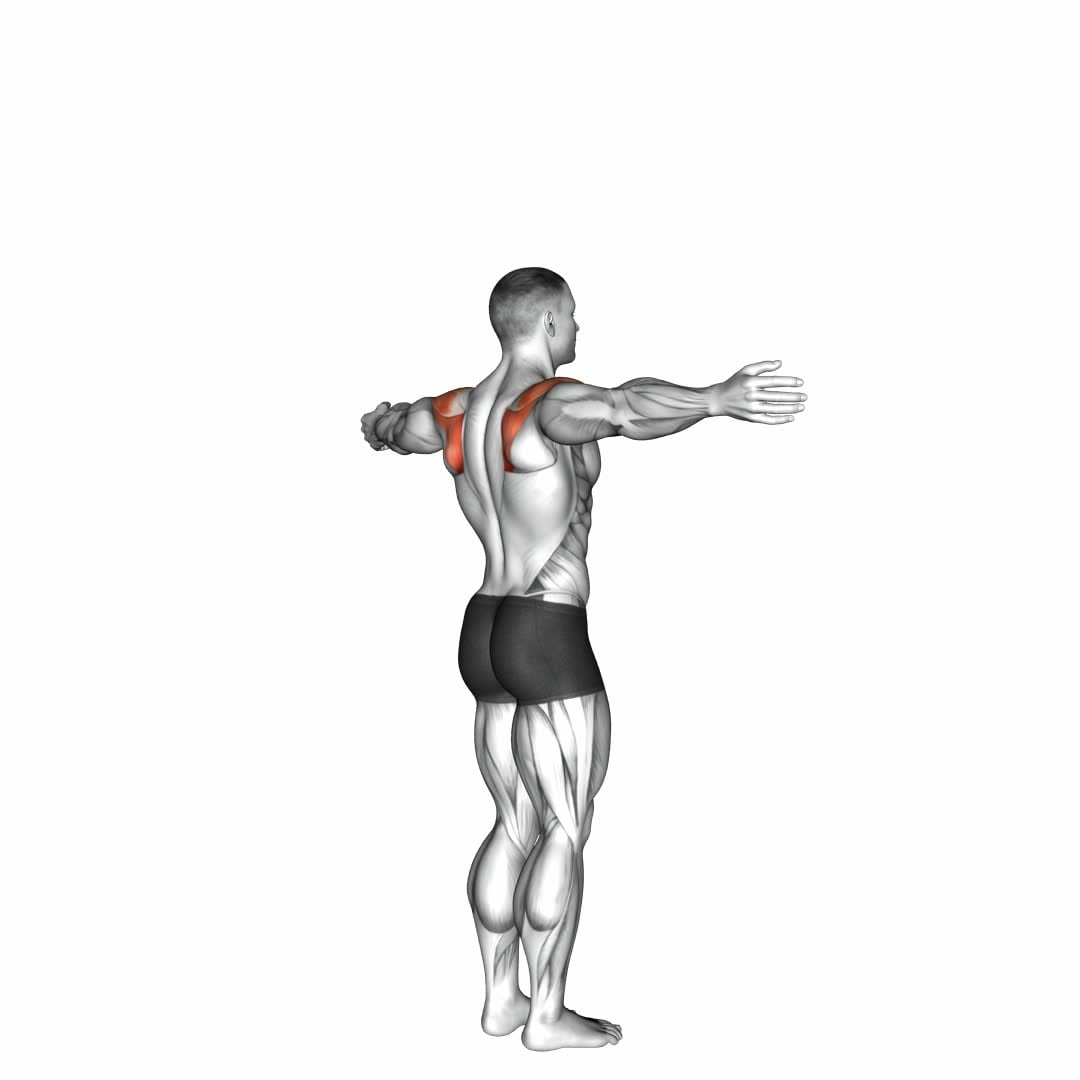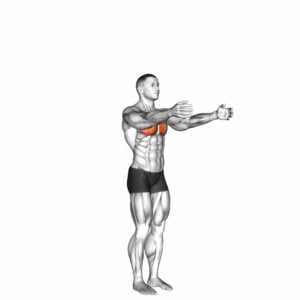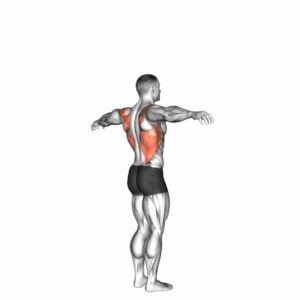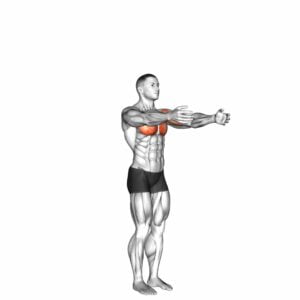Shoulder – Transverse Abduction – Video Exercise Guide & Tips

Looking to strengthen your shoulder?
Watch This Exercise Video
Check out this video exercise guide and get tips on shoulder transverse abduction.
With the right technique and variations, you can improve your shoulder mobility and stability.
Learn the benefits of this exercise, the equipment you'll need, and how to avoid common mistakes.
Get ready to take your shoulder workouts to the next level with this informative guide.
Let's get started!
Key Takeaways
- Increased shoulder stability
- Improved posture
- Prevention of injuries
- Alleviation of pain
Benefits of Shoulder Transverse Abduction
You can experience increased shoulder stability and improved posture through incorporating shoulder transverse abduction exercises into your workout routine. Shoulder health is crucial for overall upper body strength and functionality. Strengthening exercises that target the muscles involved in shoulder transverse abduction can help prevent injuries, alleviate pain, and enhance your performance in activities such as weightlifting, swimming, and throwing.
One of the key benefits of shoulder transverse abduction exercises is the improvement in shoulder stability. The muscles responsible for this movement, such as the infraspinatus and teres minor, help stabilize the shoulder joint and prevent excessive movement or dislocations. By strengthening these muscles, you can reduce the risk of shoulder instability and the associated pain and discomfort.
In addition to shoulder stability, these exercises also contribute to better posture. The muscles involved in shoulder transverse abduction work together to retract and stabilize the shoulder blades, promoting a more upright and aligned posture. This can alleviate common issues such as rounded shoulders and forward head posture, which are often associated with poor shoulder health.
Incorporating shoulder transverse abduction exercises into your routine can have a significant impact on your overall shoulder health. By improving shoulder stability and promoting better posture, you can enhance your performance in various activities and minimize the risk of shoulder injuries. Consider including exercises like standing cable external rotations and resistance band lateral raises to target and strengthen the muscles involved in shoulder transverse abduction.
Equipment Needed for Transverse Abduction Exercises
To perform transverse abduction exercises, you'll need specific equipment to effectively target and strengthen the muscles involved. When it comes to the best equipment for shoulder exercises, resistance bands are highly recommended. These bands provide variable resistance, allowing you to adjust the intensity of the exercise according to your fitness level. Additionally, they're portable and versatile, making them convenient for home workouts or when you're on the go.
Another piece of equipment that can be beneficial for transverse abduction exercises is a stability ball. By performing exercises on a stability ball, you engage your core muscles, improving stability and balance while targeting the shoulder muscles. This equipment adds an element of instability, forcing your muscles to work harder to maintain proper form.
Dumbbells are also a great option for transverse abduction exercises. They offer a wide range of weights, allowing you to gradually increase the resistance as you get stronger. Dumbbells provide a more controlled and stable movement, making them suitable for beginners or individuals with joint issues.
Lastly, a cable machine or resistance pulley system can be used for transverse abduction exercises. This equipment provides constant tension throughout the movement, helping to build strength and stability in the shoulder muscles.
Proper Technique for Shoulder Transverse Abduction
To ensure proper technique for shoulder transverse abduction, it's important to maintain proper form and engage the targeted muscles throughout the exercise. Shoulder transverse abduction is a movement that involves moving your shoulder away from the midline of your body. This exercise is beneficial for improving shoulder mobility and strengthening the rotator cuff muscles.
To perform shoulder transverse abduction correctly, start by standing upright with your feet shoulder-width apart. Hold a dumbbell in your hand with your palm facing down. Keeping your arm straight, slowly lift the dumbbell away from your body until it's parallel to the ground. Make sure to maintain control and avoid using momentum.
Throughout the exercise, focus on engaging your shoulder muscles and keeping your core stable. Imagine squeezing your shoulder blades together as you lift the dumbbell. This will help activate the muscles in your rotator cuff and promote proper alignment.
It is important to start with a weight that you can comfortably lift while maintaining proper form. As you progress, you can gradually increase the weight to continue challenging your shoulder muscles and improving your strength.
Variations and Progressions of Transverse Abduction Exercises
There are several variations and progressions you can incorporate into your transverse abduction exercises. These exercises can be done at home and are important for strengthening your shoulder muscles and improving overall shoulder stability.
One variation of transverse abduction exercises is the resistance band transverse abduction. This exercise involves attaching a resistance band to a stable object and holding the other end with your hand. Start with your arm by your side and slowly pull the band away from your body, keeping your arm straight and your shoulder blades squeezed together. This exercise adds resistance to the movement, making it more challenging and effective.
Another variation is the kneeling transverse abduction. Start by kneeling on the ground with your hands on the floor in front of you. Lift one arm out to the side, keeping it straight and parallel to the ground. Hold for a few seconds and then lower it back down. Repeat with the other arm.
Progressions of transverse abduction exercises can include increasing the resistance or using a stability ball. By using heavier resistance bands or adding weights, you can further challenge your shoulder muscles. Using a stability ball can also add an element of instability, forcing your muscles to work harder to maintain balance.
Incorporating variations and progressions into your transverse abduction exercises can help you continuously challenge your shoulder muscles and prevent plateaus in your workout routine. It's important to consult with a fitness professional or physical therapist to ensure proper form and prevent injury.
Tips for Avoiding Common Mistakes in Transverse Abduction
Avoiding common mistakes in transverse abduction can help you achieve optimal results and prevent injury. When performing transverse abduction exercises, it's important to be aware of these common mistakes to ensure that you're getting the most out of your workouts.
One common mistake is using excessive weight or resistance. While it may be tempting to push yourself to lift heavier weights, using too much resistance can compromise your form and increase the risk of injury. Instead, focus on maintaining proper technique and gradually increasing the weight as your strength improves.
Another common mistake is neglecting the role of the core muscles. The transverse abduction exercise primarily targets the shoulder, but it also engages the core muscles for stability. It's important to engage your core and maintain a strong and stable midsection throughout the exercise.
Lastly, rushing through the exercise is another common mistake. It's essential to perform transverse abduction exercises with control and proper form. Take your time and focus on the quality of each repetition rather than the quantity.
Frequently Asked Questions
How Often Should I Perform Shoulder Transverse Abduction Exercises?
To get the most out of your shoulder transverse abduction exercises, it's important to establish a regular routine. The frequency of performing these exercises depends on your fitness goals and current level of strength.
Generally, it's recommended to perform shoulder transverse abduction exercises 2-3 times a week. This will allow your muscles to recover and adapt while still providing enough stimulus for growth.
Remember to always listen to your body and adjust the frequency as needed.
Can Shoulder Transverse Abduction Exercises Help With Shoulder Impingement?
Shoulder transverse abduction exercises can be beneficial for individuals with shoulder impingement. These exercises specifically target the muscles involved in transverse abduction, which can help improve shoulder stability and reduce impingement symptoms.
Compared to other shoulder exercises, transverse abduction exercises specifically target the transverse plane of motion, allowing for a more targeted and focused workout.
Incorporating these exercises into your routine can help alleviate shoulder impingement and improve overall shoulder strength and function.
Are There Any Modifications for People With Shoulder Injuries or Limitations?
If you have shoulder injuries or limitations, there are modifications you can make to shoulder exercises. These modifications can help you avoid further injury and still work on strengthening your shoulder muscles.
Whether it's using lighter weights, adjusting the range of motion, or using resistance bands instead of free weights, there are options available to accommodate your needs.
It's important to consult with a healthcare professional or a qualified trainer to determine the best modifications for your specific situation.
What Other Exercises Can I Include in My Workout Routine to Complement Shoulder Transverse Abduction Exercises?
To complement your shoulder transverse abduction exercises, there are several other exercises you can include in your workout routine. These exercises will help strengthen and stabilize your shoulder muscles. Some options include:
- Shoulder presses
- Lateral raises
- Bent-over rows
- External rotations
Additionally, incorporating exercises for your upper back and core muscles can also support your shoulder stability.
Remember to start with lighter weights and gradually increase as you build strength and confidence.
How Long Does It Usually Take to See Results From Shoulder Transverse Abduction Exercises?
When it comes to shoulder strength training, you might be wondering how long it takes to see results from shoulder transverse abduction exercises.
Results can vary depending on factors such as your current fitness level, frequency of workouts, and intensity of exercises.
Generally, you can start noticing improvements in shoulder strength after a few weeks of consistent training.
However, it's important to remember that everyone's progress is different, so stay dedicated and patient with your shoulder transverse abduction exercises for optimal results.
Conclusion
In conclusion, shoulder transverse abduction exercises are highly beneficial for improving shoulder strength and stability. By using proper technique and gradually progressing the exercises, individuals can enhance their range of motion and prevent shoulder injuries.
It's important to use the necessary equipment and avoid common mistakes to maximize the effectiveness of these exercises. Incorporating shoulder transverse abduction into a regular workout routine can lead to improved overall shoulder function and performance.

Author
Years ago, the spark of my life’s passion ignited in my mind the moment I stepped into the local gym for the first time. The inaugural bead of perspiration, the initial endeavor, the very first surge of endorphins, and a sense of pride that washed over me post-workout marked the beginning of my deep-seated interest in strength sports, fitness, and sports nutrition. This very curiosity blossomed rapidly into a profound fascination, propelling me to earn a Master’s degree in Physical Education from the Academy of Physical Education in Krakow, followed by a Sports Manager diploma from the Jagiellonian University. My journey of growth led me to gain more specialized qualifications, such as being a certified personal trainer with a focus on sports dietetics, a lifeguard, and an instructor for wellness and corrective gymnastics. Theoretical knowledge paired seamlessly with practical experience, reinforcing my belief that the transformation of individuals under my guidance was also a reflection of my personal growth. This belief holds true even today. Each day, I strive to push the boundaries and explore new realms. These realms gently elevate me to greater heights. The unique combination of passion for my field and the continuous quest for growth fuels my drive to break new ground.







